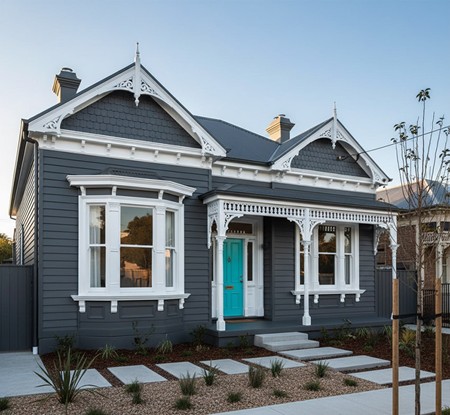Heritage buildings in Australia are some of our countries most treasured possessions. From old Victorian terraces and Federation homes right through to century-old churches, schools, and town halls, each one of these structures has got its own unique cultural and architectural value. Painting these buildings is more than just a cosmetic task – its a vital part of preserving their integrity for future generations to enjoy.
Unlike your average residential or commercial paint job, heritage painting is a bit of a balancing act. You need to respect the historical features while at the same time ensuring the long-term protection of the building from the harsh Australian climate.
Why Heritage Buildings Need Specialist Painting
Heritage buildings are often full of unique materials and construction techniques, including
- Lime render and traditional plaster – which is a whole lot more fragile than modern alternatives
- Old timber profiles and fretwork – that looks fantastic but can be a real challenge to restore
- Original weatherboards – which can be prone to decay if they’re not looked after properly
- Historic metalwork, cast iron, and steel elements – which require a lot more care than modern materials
- Stone, brick, and heritage masonry – which can be easily damaged if you’re not using the right techniques
And of course, many of these buildings still have lead-based paint on them, which requires a whole lot more care and attention.
Professional heritage painting can serve a few really important purposes:
1. Protecting Against the Elements
Australia’s harsh climate can be a real challenge for older buildings – sunshine, salt air, rain and heat can all cause problems if the building isn’t protected correctly. Using the right coating systems can help prevent all sorts of problems like cracking, rot, rust and moisture damage.
2. Preserving Architectural Value
If you’re painting a heritage building, you need to make sure you get the details right – things like trims, sash windows, mouldings and decorative features all have to be painted with care if you want to preserve the building’s historic character.
3. Compliance with Heritage Guidelines
Local councils often have very specific rules about how heritage buildings should be repainted – things like matching the original colour palette and using the right materials. If you’re not careful, you can end up with a paint job that’s not up to scratch.
Key Considerations When Painting Heritage Buildings
Painting a heritage-listed property is a bit more complicated than a standard repaint – there’s more planning and documentation involved.
1. Heritage Assessment & Colour Mapping
Before you start painting, you need to do a detailed inspection to identify things like the condition of the existing coatings the historical colour layers – sometimes you can even see the old colours by scraping away the top layer . Areas of structural concern, decayed timber or rising damp – all of these things need to be taken into account.
Some heritage projects even require colour evidence reports or council approval – especially if you’re making any major changes to the exterior.
2. Gentle, Non-Destructive Surface Preparation
When it comes to preserving original materials, gentle is good. That means avoiding heavy sanding or abrasive blasting, and instead using techniques like soft scraping, wet sanding and low-pressure washing.
3. Lead Paint Management
Many heritage buildings still have lead-based paint, and removing it requires special care. You need to follow the SafeWork NSW guidelines and make sure you contain the area properly to protect workers and anyone who might be living or working nearby.
4. Using the Correct Coating System
When it comes to choosing a coating system for a heritage building, you need to think about the substrate and how old the building is. You might need to use mineral-based or breathable paints for the masonry, or oil-based or enamel systems for the original timbers.
5. Restoring, Not Replacing
Good heritage painting is all about repairing rather than replacing – that means finding ways to fix the original materials rather than ripping them out and starting again.
Working with Access, Safety & Surrounding Community
Many heritage buildings are in busy areas, so it’s not always easy to get access. That means you need to be prepared to use scaffolding, rope access, and all sorts of other techniques to get the job done while keeping everyone safe.

Benefits of Investing in Heritage Painting
✔ Long-Term Structural Protection
Correct coatings can really make a difference in the long term – they can help prevent all sorts of problems like cracking, peeling, rising damp, timber rot and metal corrosion.
✔ Increased Property Value
A well-painted heritage facade can really boost your property value.
✔ Compliance with Council & Heritage Codes
If you get it right, you’ll be fine with the local council – no issues during inspections or future renovations.
✔ Preserving Cultural Identity
Heritage buildings are a big part of what makes our towns and cities so special – painting them properly is a way of preserving that cultural identity.
Common Challenges in Heritage Painting Projects
- Matching the original colours
- Dealing with lead-based paint
- Fragile surfaces
- Limited access to high or narrow areas
- Strict council regulations
- Weather delays
- Protecting delicate architecture
All of these challenges really highlight why heritage buildings need painters with specialist training and experience.
Final Thoughts
Heritage building painting is all about finding a balance between preserving the past and protecting the building for future generations. When you get it right, you’re not just repainting a old building – you’re preserving a bit of history.

